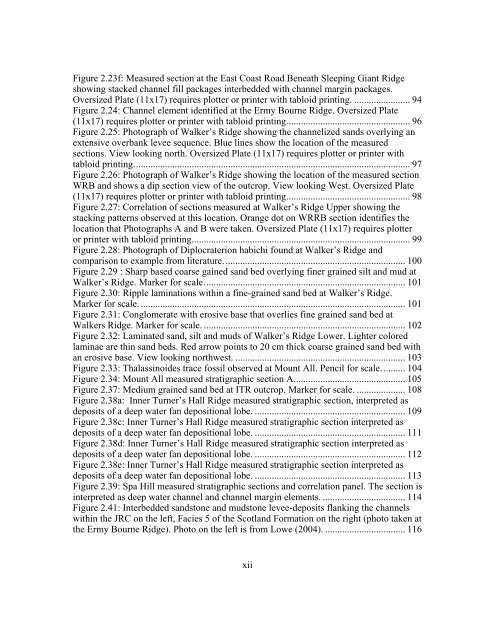Copyright by Nysha Chaderton 2009 - The University of Texas at ...
Copyright by Nysha Chaderton 2009 - The University of Texas at ...
Copyright by Nysha Chaderton 2009 - The University of Texas at ...
Create successful ePaper yourself
Turn your PDF publications into a flip-book with our unique Google optimized e-Paper software.
Figure 2.23f: Measured section <strong>at</strong> the East Coast Road Bene<strong>at</strong>h Sleeping Giant Ridge<br />
showing stacked channel fill packages interbedded with channel margin packages.<br />
Oversized Pl<strong>at</strong>e (11x17) requires plotter or printer with tabloid printing. ....................... 94<br />
Figure 2.24: Channel element identified <strong>at</strong> the Ermy Bourne Ridge. Oversized Pl<strong>at</strong>e<br />
(11x17) requires plotter or printer with tabloid printing................................................... 96<br />
Figure 2.25: Photograph <strong>of</strong> Walker’s Ridge showing the channelized sands overlying an<br />
extensive overbank levee sequence. Blue lines show the loc<strong>at</strong>ion <strong>of</strong> the measured<br />
sections. View looking north. Oversized Pl<strong>at</strong>e (11x17) requires plotter or printer with<br />
tabloid printing.................................................................................................................. 97<br />
Figure 2.26: Photograph <strong>of</strong> Walker’s Ridge showing the loc<strong>at</strong>ion <strong>of</strong> the measured section<br />
WRB and shows a dip section view <strong>of</strong> the outcrop. View looking West. Oversized Pl<strong>at</strong>e<br />
(11x17) requires plotter or printer with tabloid printing................................................... 98<br />
Figure 2.27: Correl<strong>at</strong>ion <strong>of</strong> sections measured <strong>at</strong> Walker’s Ridge Upper showing the<br />
stacking p<strong>at</strong>terns observed <strong>at</strong> this loc<strong>at</strong>ion. Orange dot on WRRB section identifies the<br />
loc<strong>at</strong>ion th<strong>at</strong> Photographs A and B were taken. Oversized Pl<strong>at</strong>e (11x17) requires plotter<br />
or printer with tabloid printing.......................................................................................... 99<br />
Figure 2.28: Photograph <strong>of</strong> Diplocr<strong>at</strong>erion habichi found <strong>at</strong> Walker’s Ridge and<br />
comparison to example from liter<strong>at</strong>ure........................................................................... 100<br />
Figure 2.29 : Sharp based coarse gained sand bed overlying finer grained silt and mud <strong>at</strong><br />
Walker’s Ridge. Marker for scale................................................................................... 101<br />
Figure 2.30: Ripple lamin<strong>at</strong>ions within a fine-grained sand bed <strong>at</strong> Walker’s Ridge.<br />
Marker for scale. ............................................................................................................. 101<br />
Figure 2.31: Conglomer<strong>at</strong>e with erosive base th<strong>at</strong> overlies fine grained sand bed <strong>at</strong><br />
Walkers Ridge. Marker for scale. ................................................................................... 102<br />
Figure 2.32: Lamin<strong>at</strong>ed sand, silt and muds <strong>of</strong> Walker’s Ridge Lower. Lighter colored<br />
laminae are thin sand beds. Red arrow points to 20 cm thick coarse grained sand bed with<br />
an erosive base. View looking northwest. ...................................................................... 103<br />
Figure 2.33: Thalassinoides trace fossil observed <strong>at</strong> Mount All. Pencil for scale.......... 104<br />
Figure 2.34: Mount All measured str<strong>at</strong>igraphic section A.............................................. 105<br />
Figure 2.37: Medium grained sand bed <strong>at</strong> ITR outcrop. Marker for scale. .................... 108<br />
Figure 2.38a: Inner Turner’s Hall Ridge measured str<strong>at</strong>igraphic section, interpreted as<br />
deposits <strong>of</strong> a deep w<strong>at</strong>er fan depositional lobe. .............................................................. 109<br />
Figure 2.38c: Inner Turner’s Hall Ridge measured str<strong>at</strong>igraphic section interpreted as<br />
deposits <strong>of</strong> a deep w<strong>at</strong>er fan depositional lobe. .............................................................. 111<br />
Figure 2.38d: Inner Turner’s Hall Ridge measured str<strong>at</strong>igraphic section interpreted as<br />
deposits <strong>of</strong> a deep w<strong>at</strong>er fan depositional lobe. .............................................................. 112<br />
Figure 2.38e: Inner Turner’s Hall Ridge measured str<strong>at</strong>igraphic section interpreted as<br />
deposits <strong>of</strong> a deep w<strong>at</strong>er fan depositional lobe. .............................................................. 113<br />
Figure 2.39: Spa Hill measured str<strong>at</strong>igraphic sections and correl<strong>at</strong>ion panel. <strong>The</strong> section is<br />
interpreted as deep w<strong>at</strong>er channel and channel margin elements. .................................. 114<br />
Figure 2.41: Interbedded sandstone and mudstone levee-deposits flanking the channels<br />
within the JRC on the left, Facies 5 <strong>of</strong> the Scotland Form<strong>at</strong>ion on the right (photo taken <strong>at</strong><br />
the Ermy Bourne Ridge). Photo on the left is from Lowe (2004). ................................. 116<br />
xii
















